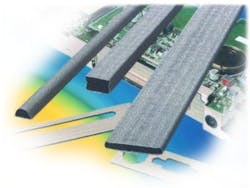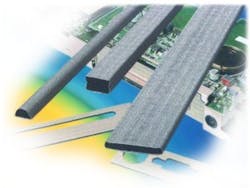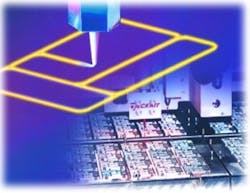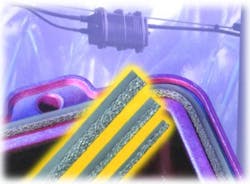In choosing the most effective EMI shielding gasket for products such as telecommunications equipment, computers, and automotive and medical electronics, often you can narrow the selection to three options: conductive fabric over foam, conductive elastomers, or beryllium-copper (BeCu) strips (fingerstock). Depending on the product’s needs, these solutions provide varying EMI protection, intricacy of forms, and environmental protection.
Several factors must be considered when designing EMI shielding into products:
- Form, referring to the complexity of the form or pattern in which the gasket fits.
- Mechanical durability.
- Attenuation level. Most commercial applications typically require 60 to 100 dB but can go as high as 120 dB.
- Compression. Most commercial applications require low closure force. Compression force has the greatest effect on conductive elastomer shielding characteristics. Since they can be loaded with relatively low- to high-conductivity filler materials, conductive elastomers supply the widest range of shielding effectiveness.
BeCu strips and conductive fabric-over-foam gaskets are not affected as much by compression forces. As a result, they offer a narrower range of shielding capabilities. See Table 1 for a comparison of typical shielding effectiveness for foam over fabric, elastomers, and BeCu strips. - Galvanic compatibility between the gasketing conductive material and substrate metal. This avoids creating a galvanic cell, which can lead to corrosion.
- Environmental sealing from water, dust, and similar external substances.
|
Gasket Type |
Typical Shielding Effectiveness |
| Conductive Fabric Over Foam | 80 to 115 dB |
| Conductive Elastomers | 40 to 120 dB |
| BeCu Strips | 75 to 120 dB |
Other selection considerations include cost, service life (cycles, actuations), tolerances, and mounting methods such as fastener types and adhesives.
Conductive Fabric Over Foam
The covering can consist of nylon thread coated with conductive metals woven into a fabric and wrapped over a soft urethane foam. Alternatively, a woven fabric may be metallized with nickel-copper or other metal coating, then wrapped around the foam core.
Flexible, conformable fabric over foam maintains close contact with surfaces with minimal compression for low-closure-force applications. It provides snug contact over irregular surfaces and around bends and corners, making it good for electronic enclosures such as doors and access panels.
Less demanding EMI applications include grounding contact pads in cell phones and laptop computers. Fabric-over-foam gaskets also can shield the input/output backplane of laptops and PCs.
The manufacturing process limits it to relatively simple cross-sectional profiles such as squares, rectangles, and D-shapes. When a more complex profile is necessary, fabric over foam may not be the best solution.
Conductive Elastomers
For more demanding shielding applications, conductive silicone elastomers provide a wide range of attenuation capabilities plus environmental and moisture sealing. The metal-filled elastomers can be extruded or molded into a wide range of form-fitting shapes and cross sections.
Conductive elastomers are filled with a range of materials, from silver (highest conductivity) to carbon. Carbon-filled elastomers, having the lowest conductivity and cost, serve applications requiring low shielding levels. Other filler materials include nickel-coated graphite, silver-plated glass, silver-plated copper, and silver-plated aluminum. Nickel-graphite is the most popular for commercial applications because of good cost/performance attributes.
BeCu Strips
Thin BeCu strips, available in many profiles, provide shielding or grounding but do not supply an environmental seal. BeCu fingerstock can be plated with many different metal types, offering broad galvanic compatibility with substrate metals.
In response to EPA restrictions and ISO 14000 requirements regarding disposal of beryllium, stainless steel is gaining preference over BeCu in many applications. Readily disposable stainless steel solves environmental problems, and provides comparable shielding effectiveness at prices similar to BeCu.
The use of stainless steel is progressing slowly because of the expense of developing new tooling. Presently, only a relatively small number of profiles are offered in stainless steel. In some cases, customers are sharing the expense of developing tooling for specific applications with the EMI gasket manufacturer.
Hybrid Shielding Materials
Two other hybrid EMI shielding options round out the designer’s choices. They can cost half that of conductive elastomers but are limited to relatively simple profiles.
In the second option, oriented monel or aluminum wires are situated perpendicularly through pads of silicone rubber. Again, simple shapes are cut from sheets of this material. Costs are lower than conductive elastomer, but the material cannot adapt to applications requiring complex forms.
Applications
A prolific application for EMI shielding materials is wireless telecommunications in base stations and cellular phones. Here are two examples:
- An aluminum casting for a wireless base station component posed both an EMI and an environmental shielding challenge because the electronics were isolated with a pattern of thin walls which formed separate compartments. The walls were too thin to accommodate fabric-over-foam or BeCu gaskets.
The solution was to mold a conductive elastomer with a rigid insert in the pattern that fit over the compartments. The resulting rigid gasket simplified assembly in the casting. - The circuit boards of a small cellular phone handset are isolated by erecting thin ledges around them and covering the ledges with EMI and environmental shielding. To lay down the ultrathin gasket, a robot dispenses a form-in-place conductive elastomer on top of the ledges.
Selecting a Solution
Conductive foam over fabric, conductive elastomer, and BeCu strips provide applications for a wide range of EMI shielding. Based on detailed data provided by the manufacturer, you can select the best EMI shielding solution. For more guidance and expertise in designing the most effective solution, consult your EMI shielding manufacturer.
About the Author
Ray Borgersen is the marketing manager at Tecknit. In previous positions at Tecknit, he was involved in EMI shielding material product management and application engineering. Mr. Borgersen holds a B.S. in mechanical engineering from the New Jersey Institute of Technology. Tecknit, 129 Dermody St., Cranford, NJ 07016, 908-272-5500, e-mail: [email protected].
Return to EE Home Page
Published by EE-Evaluation Engineering
All contents © 2000 Nelson Publishing Inc.
No reprint, distribution, or reuse in any medium is permitted
without the express written consent of the publisher.
August 2000




